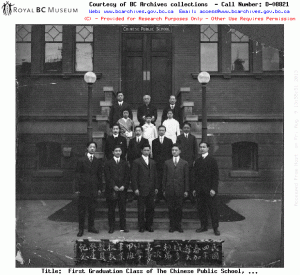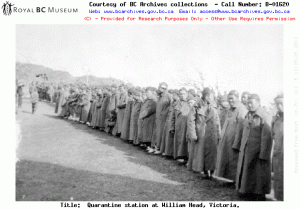Chinese Victorians and Chinatown during WWI
*Le contenu de cette page n’est pas encore disponible en français. Veuillez accepter nos excuses. Nous espérons vous offrir plus de matériel en français dès que possible.

The first graduating class of the Chinese Public School. Permission to use this image must be obtained from the BC Archives. Image Courtesy of Royal BC Museum, BC Archives – Call Number: D-08821. See BC Archives
Large-scale immigration of Chinese men to British Columbia began with the Fraser River Gold Rush of 1858. During the 1880s, another influx of Chinese labourers worked on the construction of the Canadian Pacific Railway. Racist and discriminatory attitudes towards Chinese immigrants worsened as unemployed labourers and gold seekers settled in Victoria. In 1873, an Anti-Chinese Society was founded that advocated for the exclusion and taxation of Chinese settlers. In response to anti-Chinese attitudes, the Chinese Consolidated Benevolent Association (CCBA) of Victoria was founded in 1884. The CCBA rallied the Chinese of Victoria, encouraging the further financial and social growth of what became an active Chinatown.[1] The CCBA also acted as a voice against the discrimination of Chinese residents. In 1907, when children who were not fluent in English were banned from attending public schools, the CCBA found funds to build The Imperial Chinese School (renamed the Chinese Public School in 1912) for Chinese children to attend.[2] Despite the efforts of the CCBA to protest discrimination, the Canadian federal government restricted Chinese immigration with the head tax, and social attitudes towards Chinese grew even less tolerant in the years before the First World War.
The practice in British Columbia provincial was not to allow naturalized and Canadian-born Chinese residents to enlist in the Canadian military.[3] Some British Colombians traveled to other provinces to enlist, though a clear number of Chinese volunteers is difficult to compile. Chinese living in B.C. supported the war effort by taking part in the wartime economy at home. For example, 500 Chinese workers moved from coastal communities to grow and dehydrate potatoes for troops in the field.[4] Others bought war bonds and took part in other fundraising activities.
After 1917, more than eighty-five thousand men were recruited by the Chinese government to serve in the Chinese Labour Corps (CLC) – a

Quarantine station at William Head where CLC workers were housed, 1917. Permission to use this image must be obtained from the BC Archives. Image Courtesy of Royal BC Museum, BC Archives – Call Number: D-08821. See BC Archives
workforce sent from China to Europe to dig trenches, lay railway tracks, and repair roads. Many CLC labourers trained in the Metchosin area at William Head Quarantine Station. Chinese labour battalions were largely unrecognized for their contributions even though they served alongside other allied soldiers on the frontlines. Even after serving in Europe, men returning to China were chained to ensure that they would not try to escape and settle in Canada.[5]
While the CLC labourers returned to China, many Chinese men and women were still living in Canada. In 1919, more than 500 British Columbians put forth a petition demanding that Chinese residents be allowed to vote federally.[6] This petition was denied and Chinese immigration was further restricted in the 1920s. While anti-Asian legislation was less of a priority during the war, the inter-war years saw an increase in formal barriers to immigration and full citizenship.[7] Chinese Victorians continued to actively resist discrimination. In 1922 and 1923, Chinese children living in Victoria organized a year-long strike when the Victoria School Board proposed to teach them in segregated schools. The Chinese Consolidated Benevolent Association was instrumental in protesting further segregation of education and the school board halted their proposal.[8]
By Ashley Forseille
[1] Robert Amos and Kileasa Wong, Inside Chinatown: Ancient Culture in a New World (Victoria: Touch Wood Editions, 2009), 5, 12-15.
[2] Amos Wong, Inside Chinatown, 30-35.
[3] Jenny Clayton, “Victoria Chinese Canadian Veterans Association,” Victoria’s Chinatown: A gateway to the past and present of Chinese Canadians, http://chinatown.library.uvic.ca/victoria_chinese_canadian_veterans_association (accessed 28 June 2013).
[4] Jenny Uechi, “On Remembrance Day, Chinese Canadians recall struggle for citizenship and equality,” Vancouver Observer,” 12 Nov 2012 http://www.vancouverobserver.com/world/canada/remembrance-day-chinese-canadians-recall-struggle-citizenship-and-equality (accessed 28 June 2013).
[5] Archie Wills, “Chinese coolies built CPR and defences for Canadians,” The Islander, 6 December 1981, 8; Clayton, “Victoria Chinese Canadian Veterans Association,” Victoria’s Chinatown, http://chinatown.library.uvic.ca/victoria_chinese_canadian_veterans_association (accessed 28 June 2013).
[6] 515 naturalized and Canadian-born Chinese and 200 non-Chinese British Columbians. Clayton, “Victoria Chinese Canadian Veterans Association,” Victoria’s Chinatown: A gateway to the past and present of Chinese Canadians, http://chinatown.library.uvic.ca/victoria_chinese_canadian_veterans_association (accessed 28 June 2013).
[7] Patricia Roy, White Man’s Province: B.C. Politicians and Chinese and Japanese Immigrants, 1858-1914 (Vancouver: UBC Press, 1988), 267-268.
[8] Timothy J. Stanley, “White Supremacy, Chinese Schooling, and School Segregation in Victoria: The Case of the Chinese Students’ Strike, 1922-1923.” Historical Studies in Education / Revue d’histoire de l’éducation 2 no. 2 (1990): 287-305.
Sources:
Amos, Robert and Kileasa Wong. Inside Chinatown: Ancient Culture in a New World. Victoria: Touch Wood Editions, 2009.
Victoria’s Chinatown: A gateway to the past and present of Chinese Canadians: http://chinatown.library.uvic.ca/ (accessed 28 June 2013).
Roy, Patricia. White Man’s Province: B.C. Politicians and Chinese and Japanese Immigrants, 1858-1914. Vancouver: UBC Press, 1988.
Stanley, Timothy J. “White Supremacy, Chinese Schooling, and School Segregation in Victoria: The Case of the Chinese Students’ Strike, 1922-1923.” Historical Studies in Education / Revue d’histoire de l’éducation 2 no. 2 (1990): 287-305.
Wills, Archie. “Chinese coolies built CPR and defences for Canadians.” The Islander, 6 December 1981, 8.
Further Reading:
Ashworth, Mary. The Forces Which Shaped Them: A History of the Education of Minority Group Children in British Columbia. Vancouver: New Star Books, 1979.
Chinese Canadian Military Museum Society. http://www.ccmms.ca/ (accessed 25 February 2013).
Lai, David Chuenyan. Chinese Community Leadership: Case Study of Victoria in Canada. Singapore: World Scientific Publishing Co., 2010.
Stanley, Timothy J. “White Supremacy, Chinese Schooling, and School Segregation in Victoria: The Case of the Chinese Students’ Strike, 1922-1923.” Historical Studies in Education / Revue d’histoire de l’éducation 2 no. 2 (1990): 287-305.
Stanley, Timothy J. Contesting White Supremacy: School Segregation, Anti-Racism, and the Making of Chinese Canadians. Vancouver: UBC Press, 2011.
Wickberg, Edgar, ed. From China to Canada: A History of the Chinese Communities in Canada. Toronto: McClelland and Stewart, 1982.
Wong, Kileasa Che Wan. “History and Significance of the Victoria Chinese Public School, Huaqiao Gongli Xuexiao, 1899-1999.” MA Thesis, University of Victoria, 1999.